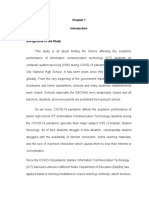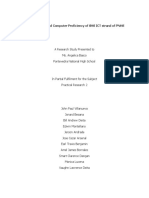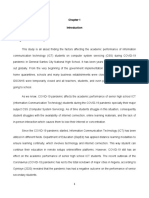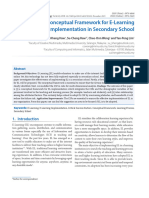0 ratings0% found this document useful (0 votes)
4 viewsJunior Senior
Junior Senior
Uploaded by
ferlynjoybayanThe document discusses several topics related to technology use and its effects. It talks about the digital divide between high and low income families and their internet access. It also discusses research on how college students' ability to learn is affected when they multitask, as well as the relationship between parental reactions and children's emotional development.
Copyright:
© All Rights Reserved
Available Formats
Download as DOCX, PDF, TXT or read online from Scribd
Junior Senior
Junior Senior
Uploaded by
ferlynjoybayan0 ratings0% found this document useful (0 votes)
4 views4 pagesThe document discusses several topics related to technology use and its effects. It talks about the digital divide between high and low income families and their internet access. It also discusses research on how college students' ability to learn is affected when they multitask, as well as the relationship between parental reactions and children's emotional development.
Original Title
JuniorSenior
Copyright
© © All Rights Reserved
Available Formats
DOCX, PDF, TXT or read online from Scribd
Share this document
Did you find this document useful?
Is this content inappropriate?
The document discusses several topics related to technology use and its effects. It talks about the digital divide between high and low income families and their internet access. It also discusses research on how college students' ability to learn is affected when they multitask, as well as the relationship between parental reactions and children's emotional development.
Copyright:
© All Rights Reserved
Available Formats
Download as DOCX, PDF, TXT or read online from Scribd
Download as docx, pdf, or txt
0 ratings0% found this document useful (0 votes)
4 views4 pagesJunior Senior
Junior Senior
Uploaded by
ferlynjoybayanThe document discusses several topics related to technology use and its effects. It talks about the digital divide between high and low income families and their internet access. It also discusses research on how college students' ability to learn is affected when they multitask, as well as the relationship between parental reactions and children's emotional development.
Copyright:
© All Rights Reserved
Available Formats
Download as DOCX, PDF, TXT or read online from Scribd
Download as docx, pdf, or txt
You are on page 1of 4
Q1 Positive.
evolved over the years and has been
Junior replicated in eight states nationwide through
5. Fast Internet Connection the sponsorship of NSF grant DUE
1003317.
During this current economic downturn of
the twenty-first century a new technological
divide is again hampering those in the
Senior
lowest income brackets and in rural areas—
1. High Performance of the devices
connectivity to broadband Internet. Just
Very high-speed computers may be
over 200 million Americans have high-
classified as follows: 1) Single Instruction
speed, wired Internet access at home while
Stream-Single Data Stream (SISD) 2)
millions of other Americans are completely
Single Instruction Stream-Multiple Data
offline (Crawford, 2011). Families reporting
Stream (SIMD) 3) Multiple Instruction
incomes of $75,000 or more have wired
Stream-Single Data Stream (MISD) 4)
high-speed Internet access in 90% of their
Multiple Instruction Stream-Multiple Data
homes compared to only 40% of homes
Stream (MIMD). "Stream," as used here,
with annual incomes below $25,000
refers to the sequence of data or
(Crawford, 2011). This new digital divide
instructions as seen by the machine during
puts at risk the quality of life for many
the execution of a program. The
Americans in a world where quick, easy
constituents of a system: storage,
access to vital information is necessary to
execution, and instruction handling
compete and survive. Many scholars and
(branching) are discussed with regard to
policy makers hypothesize that high-speed
recent developments and/or systems
Internet users are better able to make use
limitations. The constituents are discussed
of the Internet and therefore gain more
in terms of concurrent SISD systems (CDC
value when performing critical day-to-day
6600 series and, in particular, IBM Model 90
activities, as opposed to those with dial-up
series), since multiple stream organizations
access who are left behind in terms of
usually do not require any more elaborate
efficiency and capability (Dewan & Riggins,
components. Representative organizations
2005).
are selected from each class and the
9. Teacher is technically knowledgeable arrangement of the constituents is shown.
(IEEE, 2024)
In order to build teacher confidence and
increase their knowledge of the 8. Hands-On experience of students
technological software used in the PLTW
In higher education, simulation tools serve
curriculum, CCBC developed software
as important resources for student’s
specific professional development (PD)
learning. However, real laboratories cannot
training for Maryland’s middle and high
be substituted just with this tool, especially
school PLTW teachers. The training in
in some fields such as Automatics and
Maryland has been conducted with the
Robotics, in which the actual behavior and
support of The University of Maryland,
response of the real elements in the
Baltimore County (UMBC), Maryland’s
experiments is crucial (Alhalabi, Marcovitz,
PLTW Affiliate University, for the pre-
Hamza, & Petrie, 2000). Remote
engineering program. UMBC provides
laboratories, which also deliver laboratory
training, support and PD to guidance
facilities to the door of the student such as
counselors as well as PLTW teachers.
the simulation software is intended to do
Maryland’s PD training program has
(Gorrel, 1992), may constitute a better
substitute or complement to real hands-on
experiments. Moreover, virtual laboratories
should be used to serve as an initial
experimentation and a first contact with the
studied phenomena for the student. In this
way, VRLs are essential educational tools
which provide students real-simulated
experiments that can be conducted at any
time, without instructor surveillance or
guidance. Thus, each student learns with
hands-on experiences in a way that can
practically fit into their education schedule.
In addition, expensive equipment can be
shared among students enrolled in different
programs and with different schedules and
knowledge levels.
Q1 Negative begun to examine how college students
multitask and how this affects their ability to
Junior
learn material and engage in the learning
1. Slow speed of computer units
process (Fried, 2008, Junco and Cotten,
Slow Tech offers people the opportunity, on 2011, Junco and Cotten, 2012, Mayer and
the one hand, to spend more time on Moreno, 2003, Rosen et al., 2011, Wood et
thought, observation, and choice and, on al., 2012).
the other, to enjoy their short lives more.
10. Encountered problems within the
Slow Tech introduces the time dimension
family
into thinking about technology. It means
that, while people continue to use ICT in the Parental participation and learning effect
future, they may do so in a more conscious how parents treat their children, as well as
and responsible way. It implies that people how they handle their children's habits and
will need to regain control of the pace of cognitive processes (28). This, in turn,
their days and lives, by designing shapes their children's performance and
technologies that are more respectful of behaviors toward them. As a result, the
their brains and bodies and that are not parent-child relationship is dependent on
necessarily based on a continual increase in the parents' attitudes, understanding, and
clock speed. It highlights the importance of perspectives. When parents have positive
starting to examine longer-term, human views, the relationship between them and
oriented perspectives. K.K. Kimppa et al. their children will be considerably better
(Eds.): HCC11 2014, IFIP AICT 431, pp. than when they have negative attitudes.
122–135, 2014. Parents respond to unpleasant emotions in
a variety of ways, which can be classified as
supportive or non-supportive (29). Parents'
6. Concentrated on other activities rather supportive reactions encourage children to
than computer system servicing tasks explore their emotions by encouraging them
during laboratory sessions to express them or by assisting them in
understanding and coping with an emotion-
Research on multitasking has uncovered eliciting scenario. Non-supportive behaviors,
clear evidence that human information such as downplaying the kid's emotional
processing is insufficient for attending to experience, disciplining the child, or getting
multiple stimuli and for performing concerned by the child's display, transmit
simultaneous tasks (Chun et al., 2011, Koch the child the message that expressing
et al., 2011, Marois and Ivanoff, 2005, unpleasant emotions is inappropriate and
Rosen et al., 2011, Tombu et al., 2011, unacceptable. Supportive parental reactions
Wood and Cowan, 1995, Wood et al., to unpleasant emotions in children have
2012). Almost all of the research on been linked to dimensions of emotional and
multitasking is conducted in the cognitive social competence, such as emotion
sciences and focuses on simple tasks such comprehension and friendship quality. Non-
as attending to a stream of words presented supportive or repressive parental reactions,
to one ear while a distractor stream is on the other hand, have been connected to
presented to the other. However, there is a child's stored negative affect and
evidence that these performance disordered behaviors during emotion-
decrements extend to more complex tasks. evoking events, probably due to an inability
Because of shifts in student technology or unwillingness to communicate unpleasant
ownership and use, researchers have sentiments.
Senior
1. Slow Speed of Computer Units
Slow Tech offers people the opportunity, on
the one hand, to spend more time on
thought, observation, and choice and, on
the other, to enjoy their short lives more.
Slow Tech introduces the time dimension
into thinking about technology. It means
that, while people continue to use ICT in the
future, they may do so in a more conscious
and responsible way. It implies that people
will need to regain control of the pace of
their days and lives, by designing
technologies that are more respectful of
their brains and bodies and that are not
necessarily based on a continual increase in
clock speed. It highlights the importance of
starting to examine longer-term, human
oriented perspectives. K.K. Kimppa et al.
(Eds.): HCC11 2014, IFIP AICT 431, pp.
122–135, 2014.
7. Peer Pressure
Peer pressure is often seen during the
adolescence stage of a teenagers because
they often seek comfort among their peers
and intend to do what their peers does
without knowing if it is good or bad for them.
Adolescence is a period of an individual that
is transitory when a child reaches the point
in changing its childhood to adulthood
(Adeniyi & Kolawole, 2015). Thus,
individuals are prone temptations in the
social contextualization concepts, for
example, socializing with others tend to do
some activities such as napping and
drinking during classes or work day (Bonein
& Denont- Boemont, 2013).
You might also like
- Sample 1Document22 pagesSample 1Candaba Mdrrmo100% (2)
- The Impacts of Modern Technology On Grade 12 StudentsDocument11 pagesThe Impacts of Modern Technology On Grade 12 StudentsJean Lorie May Ibañez83% (6)
- What Is Public Choice Theory PDFDocument8 pagesWhat Is Public Choice Theory PDFSita SivalingamNo ratings yet
- LITERATURE IctDocument2 pagesLITERATURE Ictlydiahwmwangi.lwmNo ratings yet
- 2010 Innovations Conference ProgramDocument6 pages2010 Innovations Conference ProgramlcscheduleNo ratings yet
- Gadgets: The Usage by Iglesia Ni Cristo Kagawad Members of The Pagsamba NG Kabataan Attending Jovita Elementary SchoolDocument9 pagesGadgets: The Usage by Iglesia Ni Cristo Kagawad Members of The Pagsamba NG Kabataan Attending Jovita Elementary SchoolEmer Ureta TelicNo ratings yet
- Inc. Integrated Basic Education Department: Lourdes CollegeDocument10 pagesInc. Integrated Basic Education Department: Lourdes CollegeLar KenNo ratings yet
- Chapter 123Document26 pagesChapter 123Importante RyanNo ratings yet
- Information Technology Thy Quality Success StoryDocument5 pagesInformation Technology Thy Quality Success StoryDr Dheeraj MehrotraNo ratings yet
- European Journal of Theoretical and Applied SciencesDocument9 pagesEuropean Journal of Theoretical and Applied SciencesEJTAS journalNo ratings yet
- Factors Influencing Senior High School Students Computer LiteracyDocument10 pagesFactors Influencing Senior High School Students Computer Literacyjovie TaboradaNo ratings yet
- Teaching and Learning With TehcnologyDocument14 pagesTeaching and Learning With Tehcnologyapi-584217092No ratings yet
- Bob ResumeDocument10 pagesBob ResumeBOBBY BATUCANNo ratings yet
- Introduction Group 2Document26 pagesIntroduction Group 2Niel Ivan MontesaNo ratings yet
- UntitledDocument35 pagesUntitledRhylyn Khaye ReyesNo ratings yet
- 054 Iconistech2019hnpDocument14 pages054 Iconistech2019hnpVictorNo ratings yet
- PR-Final-5 30 2023Document24 pagesPR-Final-5 30 2023Charmel AnciroNo ratings yet
- Chap 1 and 2 FinalDocument20 pagesChap 1 and 2 FinalANT0N1ONo ratings yet
- Chapter 1 Miss BandiezDocument20 pagesChapter 1 Miss BandiezCyra Mae JoseNo ratings yet
- Guidlines For Online AssessmentDocument10 pagesGuidlines For Online Assessmentthanhtrang23No ratings yet
- Research 1Document5 pagesResearch 1Vince Joshua Aquino CaturaNo ratings yet
- Artigas PR1Document36 pagesArtigas PR1almeroapriljeanNo ratings yet
- PR Relationship Between Computer Literacy and Student MotivationDocument31 pagesPR Relationship Between Computer Literacy and Student MotivationJoy Ibarreta Malagueño-OlmedilloNo ratings yet
- Research Proposal AssignmentDocument16 pagesResearch Proposal AssignmentMwape MusondaNo ratings yet
- Etude de Spiezia-PaperDocument23 pagesEtude de Spiezia-PaperNdéye Diakhou DIAW SYNo ratings yet
- Chapter 1 To 5. Brucal GroupDocument18 pagesChapter 1 To 5. Brucal GroupSHIELA MAY MERCADO BRUCALNo ratings yet
- TalisicDocument34 pagesTalisicDavid QuisayNo ratings yet
- RRL 11 22Document10 pagesRRL 11 22Yo, AngeloNo ratings yet
- Abm 12 ResearchDocument22 pagesAbm 12 ResearchJenelyn ToqueroNo ratings yet
- Ict Dissertation ExamplesDocument4 pagesIct Dissertation ExamplesBuyCheapPaperUK100% (1)
- ICT Use and Computer Proficiency of SHS ICT Strand of PNHS 3Document12 pagesICT Use and Computer Proficiency of SHS ICT Strand of PNHS 3Smart DanganNo ratings yet
- I Utilization of E-Gadgets Among Senior High School Student in Polytechnic College of Davao Del Sur, Inc. SY 2017-2018Document22 pagesI Utilization of E-Gadgets Among Senior High School Student in Polytechnic College of Davao Del Sur, Inc. SY 2017-2018kenken the ExplorerNo ratings yet
- A Case Study of Lagos State UniversityDocument12 pagesA Case Study of Lagos State Universitygodwin peaceNo ratings yet
- Artigas PR1 Printing - 102214Document39 pagesArtigas PR1 Printing - 102214almeroapriljeanNo ratings yet
- VLC ThesisDocument4 pagesVLC Thesisokxyghxff100% (2)
- Digital ToolsDocument17 pagesDigital Toolssofia domingosNo ratings yet
- CHAPTER 123 Ready 2 PrintDocument20 pagesCHAPTER 123 Ready 2 PrintImportante RyanNo ratings yet
- Bartholomew Research PaperDocument13 pagesBartholomew Research PaperFrances FernandezNo ratings yet
- Education in Industry 4.0 Effectiveness of Handheld Computer in Remote LearningDocument10 pagesEducation in Industry 4.0 Effectiveness of Handheld Computer in Remote LearningInternational Journal of Innovative Science and Research TechnologyNo ratings yet
- Will Tec H Nology Transform Education For The Better: Evidence ReviewDocument20 pagesWill Tec H Nology Transform Education For The Better: Evidence ReviewSerge Bibauw100% (2)
- Federated and Continual Learning For Classification Tasks in A Society of DevicesDocument16 pagesFederated and Continual Learning For Classification Tasks in A Society of DevicespapapapaNo ratings yet
- RESEARCHPROJECTDocument32 pagesRESEARCHPROJECTBevsly VillonesNo ratings yet
- Effects of Using Gadgets To The Level of Performance in MathematicsDocument8 pagesEffects of Using Gadgets To The Level of Performance in MathematicsCarlo Delos SantosNo ratings yet
- Classifying Emotional Engagement in Online Learning Via Deep Learning ArchitectureDocument8 pagesClassifying Emotional Engagement in Online Learning Via Deep Learning ArchitecturePoonam KilaniyaNo ratings yet
- Chas Final Draft Internet Assignment 2Document9 pagesChas Final Draft Internet Assignment 2api-288857245No ratings yet
- Technology For Teaching and LearningDocument7 pagesTechnology For Teaching and Learningcharlesbagtas8No ratings yet
- Impact of Information and Communication Technology in The Learning of Selected Junior High Students and Teachers in Niño Jesus House of Studies IncDocument38 pagesImpact of Information and Communication Technology in The Learning of Selected Junior High Students and Teachers in Niño Jesus House of Studies IncKylie CadenasNo ratings yet
- Problem and Its Background: Pres. Diosdadomacapagal High SchoolDocument55 pagesProblem and Its Background: Pres. Diosdadomacapagal High SchoolJater Jay Iman SabusabNo ratings yet
- Chapter 1Document13 pagesChapter 1Viñas, Diana L.No ratings yet
- Evolving Patterns of WorkingDocument18 pagesEvolving Patterns of Workinggerardo_romero_41No ratings yet
- 5306 22757 1 PBDocument5 pages5306 22757 1 PBsiam siamNo ratings yet
- Q3 G11 Empowerment Technologies Module 1Document30 pagesQ3 G11 Empowerment Technologies Module 1JR BalleNo ratings yet
- Mil M8Document6 pagesMil M8darunday charesmaNo ratings yet
- Research Review: Research Title: Mobile Technologies and LearningDocument2 pagesResearch Review: Research Title: Mobile Technologies and LearningXelwiin BongonNo ratings yet
- Ict 2Document28 pagesIct 2Iron Brix SantiagoNo ratings yet
- Article 104Document7 pagesArticle 104jonel macasinagNo ratings yet
- Capabilities of Using Different Learning Modalities of Grade 12 - Students of St. Benilde Center For Global Competence Inc. A.Y. 2020 - 2021Document11 pagesCapabilities of Using Different Learning Modalities of Grade 12 - Students of St. Benilde Center For Global Competence Inc. A.Y. 2020 - 2021Reyjohn EbeNo ratings yet
- Student Information System Its Efficacy Towards Student Tracking ProgramDocument13 pagesStudent Information System Its Efficacy Towards Student Tracking ProgramAlexander CataminNo ratings yet
- Chapter 1 Research 12 FontDocument10 pagesChapter 1 Research 12 Fontpherjanes0215No ratings yet
- Evaluating The Effectiveness of ComputerDocument5 pagesEvaluating The Effectiveness of ComputerJaeszel PacpacNo ratings yet
- Efficacious Technology Management: A Guide for School LeadersFrom EverandEfficacious Technology Management: A Guide for School LeadersNo ratings yet
- Cambridge IGCSE ™: First Language English 0500/13 October/November 2022Document21 pagesCambridge IGCSE ™: First Language English 0500/13 October/November 2022janehilger9No ratings yet
- Tarthang Tulku Openness MindDocument88 pagesTarthang Tulku Openness MindJames Lee100% (1)
- THESIS FINAAAAAL With Appendix Converted With DateminDocument62 pagesTHESIS FINAAAAAL With Appendix Converted With DateminKhurmhelyNo ratings yet
- Stasz AssessingSkillsWork 2001Document22 pagesStasz AssessingSkillsWork 2001vyonabusinessNo ratings yet
- Health and Social Psychology Master 2014 2015Document13 pagesHealth and Social Psychology Master 2014 2015Elisa RodriguezNo ratings yet
- Oliveira - 2020 - Ecological Psychology and The Environmentalist Promise of AffordancesDocument6 pagesOliveira - 2020 - Ecological Psychology and The Environmentalist Promise of AffordancesDino MurthyNo ratings yet
- PERSONALITY DEVELOPMENT CHAPTER 1 MaemaeDocument11 pagesPERSONALITY DEVELOPMENT CHAPTER 1 MaemaeFreshDianne Mhilkie Silvosa100% (1)
- Charles D Hayes Self University The Price of Tuition Is The Desire To Learn Your Degree Is A Better Life PDFDocument263 pagesCharles D Hayes Self University The Price of Tuition Is The Desire To Learn Your Degree Is A Better Life PDFRay CactusNo ratings yet
- Organizational Behaviour MCQ With Answers: Step 1: Click HereDocument8 pagesOrganizational Behaviour MCQ With Answers: Step 1: Click Hereabhi63465No ratings yet
- Theories of Mass Communication PDFDocument18 pagesTheories of Mass Communication PDFBilal Imran100% (1)
- Employee As A Tool For Brand IDocument184 pagesEmployee As A Tool For Brand IShireesha SanguNo ratings yet
- Research Problems, Variables, and HypothesesDocument9 pagesResearch Problems, Variables, and HypothesesFaisalameen73No ratings yet
- SuggestopediaDocument54 pagesSuggestopediaRafika ZherlyNo ratings yet
- Chapter 12 SummaryDocument3 pagesChapter 12 SummarymualtukNo ratings yet
- HSP Chemistry frm5 PDFDocument61 pagesHSP Chemistry frm5 PDFSiti Suriani Mohd YusofNo ratings yet
- Independent and Dependent VariablesDocument6 pagesIndependent and Dependent VariablesDawn Lewis100% (2)
- Adoption of Whatsapp Instant Messaging Among Students in Ipoh Higher Education InstitutionsDocument102 pagesAdoption of Whatsapp Instant Messaging Among Students in Ipoh Higher Education InstitutionszenNo ratings yet
- Social Science Thesis StatementDocument6 pagesSocial Science Thesis Statementashleyrichardsalbuquerque100% (2)
- CB - B Project Group 8Document14 pagesCB - B Project Group 8shivam sharmaNo ratings yet
- Improving Employee's Work Life Balance in The Construction IndustryDocument9 pagesImproving Employee's Work Life Balance in The Construction IndustryManglam AgarwalNo ratings yet
- Syllabus Class: - B.B.A. VI SemesterDocument22 pagesSyllabus Class: - B.B.A. VI Semesteralisha bhatnagarNo ratings yet
- Sukumar - Mba Project-Consumer Perceoption in SagoSERVEDocument107 pagesSukumar - Mba Project-Consumer Perceoption in SagoSERVEPrasanna KumarNo ratings yet
- PSY403Document31 pagesPSY403Waqar Ahmed0% (1)
- 1BEHVCOMM Module 1 Lesson 3Document13 pages1BEHVCOMM Module 1 Lesson 3Pia BondocNo ratings yet
- Emotional 9Document26 pagesEmotional 9Mohammed Yehia Shab-anNo ratings yet
- Absent I SeemDocument24 pagesAbsent I Seemڤوتري جنتايوNo ratings yet
- Proposal To Research Romantic Reality TV and Romantic/Sexual Life SatisfactionDocument12 pagesProposal To Research Romantic Reality TV and Romantic/Sexual Life SatisfactionHaley KershawNo ratings yet
- Family Nursing Care Plan A, D, PDocument44 pagesFamily Nursing Care Plan A, D, PYuunaFuentesLegaspiNo ratings yet
- Microaggressions Clarification, Evidence, and Impact Williams2019Document24 pagesMicroaggressions Clarification, Evidence, and Impact Williams2019Salman TahirNo ratings yet

























































































